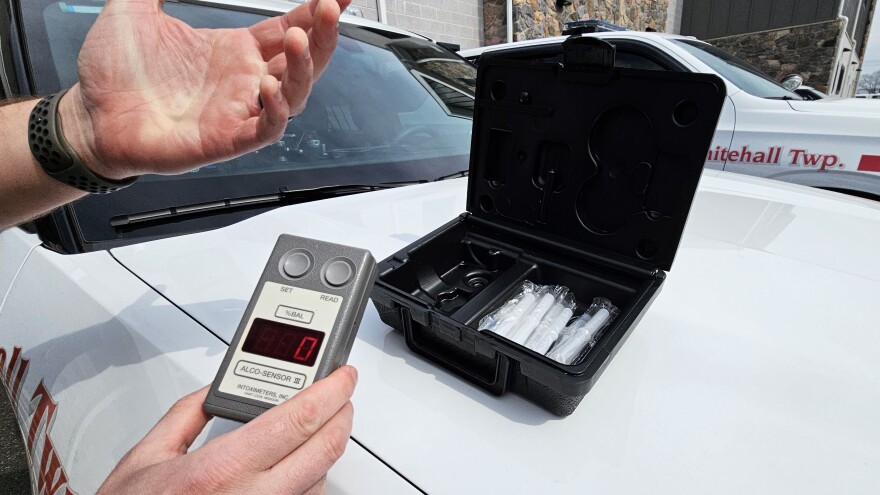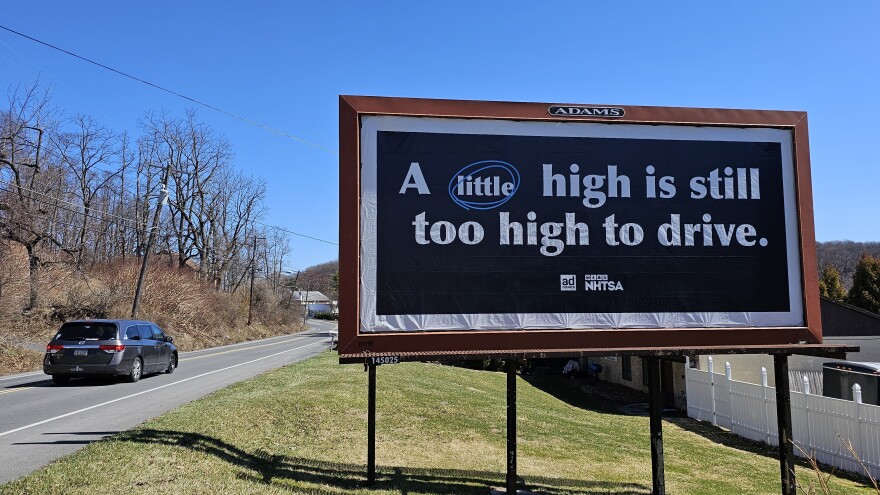The Road Ahead is a project by LehighValleyNews.com on traffic and transportation issues in Lehigh and Northampton counties. This is PART THREE of the series, which includes this related story:
Discipline for DUI: 'Striking a balance' between prevention and punishment
BETHLEHEM, Pa. — The statistics are sobering.
About 1.2 million people die in road traffic crashes each year, with a significant portion involving alcohol or drugs, according to the World Health Organization.
More than 13,500 people in the United States died in alcohol-impaired crashes in 2022 — about one death every 39 minutes, the National Highway Traffic Safety Administration estimates, with about 32% of all traffic crash fatalities in the country involving impaired drivers.
That’s up from an average of about 11,000 annual deaths from drunk-driving crashes for the decade spanning 2013-2022, NHTSA data shows.
Almost half of drivers killed in those crashes tested positive for drugs and about one-third of all DUI arrests involve repeat offenders, according to studies.
In the Lehigh Valley, impaired driving is among the most persistent threats to road safety.
Almost 200 people were killed in impaired-driving crashes in the region between 2014 and 2023, according to the Pennsylvania Department of Transportation.
And it results in thousands of accidents and arrests each year.
Lehigh County recorded about 1,750 impaired-driving cases in 2024, a rise of almost 42% over the past five years, according to county statistics.
Northampton County had 756 impaired-driving cases in 2024, the same number it processed in 2020. But cases were significantly higher in the three years between, peaking at 992 in 2022, county statistics show.
DUI trends
DUI arrests cut across all ages and demographics, two of the region’s chief prosecutors told LehighValleyNews.com.
But some trends are evident, according to Lehigh County District Attorney Gavin Holihan.
Younger people are drinking less, and those who are drinking more are in their 40s, 50s and 60s, Holihan said. And women in Lehigh County seem to be drinking heavily more than before, he said.
Trends in neighboring Northampton County show heavily drunk drivers are getting behind the wheel more often, Deputy District Attorney Joseph Lupackino said.
Third-tier offenses, in which a driver has a blood alcohol level of 0.16 — twice the legal limit — or more are among the more common DUI-related arrests in the county, he said.
Route 33 surpassed Interstate 78 as the second-busiest in the Lehigh Valley — after Route 22.LehighValleyNews.com analysis
More people driving at that high level of impairment is “obviously … concerning” for prosecutors — and other drivers on the road, Lupackino said.
Fifteen years as an assistant district attorney in Northampton County have made it clear to Lupackino that rising national trends on dangerous-driving incidents — speeding, aggressive driving and road-rage cases — are playing out on local roads, too.
“You're definitely seeing people drive much more aggressively,” Lupackino said, highlighting several cases where drivers are clocked traveling “well over 100 miles an hour.”
He flagged Route 33 as an area of particular concern, one where drivers are routinely hitting the highest rates of speed. The highway surpassed Interstate 78 as the second-busiest in the Lehigh Valley — after Route 22/I-78 west of the merge — an analysis by LehighValleyNews.com shows.
Dangerous driving can be an indicator of impaired driving.
Many who are later charged with DUIs are stopped by police due to “reckless” or “careless” driving that catches officers’ attention, Lupackino said.
They often commit a host of traffic offenses, like “weaving, leaving the road or their lane of travel, going over the fog line, the double yellow, or speeding,” Lupackino said.
“A lot of those times, those are the basis for the stop itself,” he said.
Should the legal limit be lowered?
Lupackino said no clear patterns have emerged to identify the “typical” DUI offender, which the state deems anyone of legal drinking age charged with having a BAC of .08 or higher or those determined to be under the influence of controlled substances.
“There’s not one specific type of person who gets charged with a DUI,” Lupackino said.
Northampton County prosecutors filed charges against 756 impaired drivers in 2024, according to the most recent data from the county. That’s down almost 24% from almost 1,000 in 2022 but equal to the number of impaired-driving charges filed in 2020.
Some of those DUI arrests involve people “who have been out and had maybe one or two too many and thought they were good to drive,” he said.
But a greater worry for Lupackino is drivers with a higher concentration of alcohol in their system.
“I’m sure I don’t have to tell you the dangers of operating (a vehicle) with a high BAC, or even a mid-tier BAC,” considered to be between 0.10 and 0.16, he said.
Numerous studies illustrate those dangers.
A 2013 report from the National Transportation Safety Board cited studies that showed drivers with a BAC of .05 had a 38% higher risk of crashing than those with no alcohol in their system. That risk rose 169% at .08, the legal limit in 49 states.
A 150-pound woman can reach a .05 BAC with about two drinks in two hours, while a 200-pound man would need about three drinks over the same period. That level of impairment can make it difficult to steer and hard to react correctly to other vehicles on the road, according to studies.
Drivers with a .08 BAC have trouble concentrating, experience impaired perceptions and can suffer short-term memory loss. Those effects are exacerbated by higher BACs.
In its 2013 report, the NTSB recommended the legal BAC limit for driving be set at .05, as it is in Utah.
That would reduce the number of fatal crashes involving drivers at all BAC levels and send “a message that the government is getting tougher on impaired driving, and society will not tolerate impaired drivers,” according to James Fell, a principal research scientist who studies traffic safety at the independent research organization NORC at the University of Chicago.
During traffic stops, officers can use in-car breathalyzers, call county drug-recognition experts to evaluate drivers or seek a sample of drivers’ blood to determine impairment.

Test results “come back fairly quickly” but can lead to delays between someone’s arrest and arraignment, Holihan said.
Driving while high
Blood samples remove ambiguity about drivers’ impairment from marijuana.
The drug is involved in a growing number of DUI cases in the Lehigh Valley, where medical marijuana is sold and recreational marijuana is available within a short drive to many residents.
Northampton County officials, many of whom work minutes from a dispensary in Phillipsburg, are seeing an increase in marijuana-related DUIs, Lupackino said.
“We see that people think that if they have a medical marijuana card, for some reason, it’s legal to drive, even under the influence of medical marijuana. It’s not. … You get a DUI for that.”Lehigh County District Attorney Gavin Holihan
Marijuana DUI arrests are climbing in Lehigh County, about 30 minutes west of where it’s easily purchasable.
Yet the possession of marijuana remains a federal crime; it’s a Schedule 1 drug deemed to have “no currently accepted medical use and a high potential for abuse,” according to the U.S. Drug Enforcement Agency.
Due to its classification alongside heroin, LSD, ecstasy and bath salts, prosecutors are authorized to file DUI charges against drivers found to have any trace of marijuana in their system, Holihan said.

But prosecutors in Lehigh, Northampton and many Pennsylvania counties only charge drivers with DUI if they’re found to have active metabolites in their systems.
Active metabolites show a driver’s body was still breaking down the drug when their blood was drawn, indicating recent use and impairment, Holihan said.
Charging drivers whose blood tests show inactive metabolites — indicating they weren’t impaired — is “not [in] the spirit of the law,” he said.
The legal standard for proving drivers’ impairment from marijuana could change if it’s reclassified as a Schedule 3 drug or legalized recreationally in Pennsylvania, Holihan said.
Full legalization could “complicate our ability to prosecute” marijuana-related DUI charges, according to Lupackino.
“I think you could still prosecute them, but it would become more challenging,” he said.
Holihan acknowledged a “dichotomy” between state and federal marijuana laws. But he cautioned drivers that medical marijuana cards are not get-out-of-jail-free cards.
“We see that people think that if they have a medical marijuana card, for some reason, it’s legal to drive, even under the influence of medical marijuana,” Holihan said. “It’s not. … You get a DUI for that.”
Lehigh County’s top law enforcement official highlighted the strength of legal marijuana, noting marijuana that’s illegally produced and sold is getting more potent to compete.
“It takes less to get people more intoxicated,” Holihan said, identifying that as another danger on Pennsylvania’s roads.
Making streets safer
County prosecutors are responsible for continually processing and litigating DUI cases. But they have a somewhat limited role in making streets safer, beyond whatever deterrence effect arises from prosecuting defendants and offering them diversionary opportunities, according to Holihan.
Prosecutors can develop strategies to help address “big-picture crimes” — those he categorized as being “driven by poverty [and] lack of opportunity.”
“There’s a lot of engineering solutions, but those are not the kinds of things that you can do as a prosecutor’s office."Lehigh County District Attorney Gavin Holihan
But it’s harder to “identify people who are going to drive too fast” or impaired and divert them into preventive programs, Holihan said.
“Everything that we see is after the fact,” he said, noting prosecutors get involved after a crash or arrest.
Much of the onus to make streets safer is on other public officials and engineers who can shape the way roads are built and used — and limit the need for prosecutors — he implied.
Holihan highlighted “simple” solutions like speed humps, narrowed streets and pedestrian crossings.
“There’s a lot of engineering solutions, but those are not the kinds of things that you can do as a prosecutor’s office,” he said.
Two cities in the Lehigh Valley are taking the lead on roadway-safety initiatives.
Easton is working to reduce roadway deaths and injuries 75% by 2030. Officials are using Easton’s Safe Streets for All survey to pinpoint the city’s biggest problem areas and safety issues.
Allentown’s Safe Streets program is pushing to end all pedestrian deaths by 2030 and reduce fatalities and injuries from vehicle crashes.
The city is set to soon install high-visibility crosswalks, repaint roads and test other “traffic-calming” methods with funding from the U.S. Department of Transportation.
Mayor Matt Tuerk said those changes “will slow things down and make things safer for all of our roadway users.”
Hundreds of people who responded to a citywide Safe Streets survey said speeding motorists are the biggest safety issue in Allentown.
Tuerk and other officials are expected to present the city’s Safe Streets for All action plan to Allentown City Council on April 2.
Both cities also adopted “Vision Zero” strategies with similar road-safety goals.
COMING TOMORROW - PART 4: Only a handful of Lehigh Valley school districts offer driver education of some kind.



